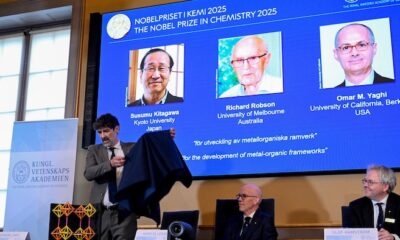Science
Researchers Achieve Breakthrough in Antiproton Spin Control

Physicists have made a significant advancement in understanding antimatter by successfully conducting coherent spin spectroscopy on a single antiproton. The research, carried out by the BASE collaboration at CERN, marks a record-breaking precision in measuring the magnetic properties of antimatter. This milestone could provide insights into the perplexing disparity between matter and antimatter in the universe.
Dmitry Budker, a physicist at the University of California, Berkeley, and not involved in the study, remarked, “The level of control the authors have achieved over an individual antimatter particle is unprecedented.” He emphasized that this breakthrough opens the door for more precise examinations of fundamental symmetries in nature.
Scientists have long grappled with the question of why the universe appears to be predominantly composed of matter, despite theories suggesting it should have originated with equal amounts of both matter and antimatter. This cosmic imbalance, known as the baryon asymmetry problem, remains one of the most significant unanswered questions in physics.
Stefan Ulmer, a senior member of the BASE team and head of the Ulmer Fundamental Symmetries Laboratory at RIKEN in Japan, explained, “The general motivation for studying antiprotons is to test fundamental symmetries and our understanding of them.” The current understanding posits that protons and antiprotons should share identical masses but have equal and opposite electrical charges. Any deviations from these expectations could illuminate the reasons behind baryon asymmetry.
The BASE team focused on coherent spectroscopy, a quantum technique that manipulates the spin states of a single antiproton using microwave pulses. Ulmer described the process: “We were doing spectroscopy on the spin of a single trapped antiproton, stored in a cryogenic Penning trap system. It is significant because this is of highest importance in studying the fundamental properties of the particle.”
By applying microwave radiation at precise frequencies, the researchers induced Rabi oscillations—periodic flipping of the antiproton’s spin—and identified the resulting resonances. The key outcome was a resonance peak that was 16 times narrower than any previous measurements of antiprotons. This enhanced precision allows for a more accurate determination of the transition frequency.
The team’s work also achieved a 1.5-fold improvement in the signal-to-noise ratio, paving the way for a tenfold increase in the precision of antiproton magnetic moment measurements. Ulmer noted, “In principle, we could reduce the linewidth by another factor of ten if additional technology is developed.”
Budker characterized the measurement as groundbreaking, stating, “This is a key to future precise tests of CPT invariance and other fundamental-physics experiments.” CPT symmetry refers to the principle that the laws of physics remain unchanged when charge, parity, and time are simultaneously reversed. Testing this principle with increasing precision is vital for uncovering any inconsistencies within the Standard Model of particle physics.
The BASE team observed antiproton spin coherence times of up to 50 seconds. Coherence, in this context, refers to the stability of the antiproton’s quantum spin state over time, which is essential for achieving high-precision measurements. Measuring the magnetic moments of nuclear particles presents considerable challenges, and conducting such measurements on antimatter further stretches the limits of experimental physics.
Ulmer stated, “These measurements require the development of experiments that are about three orders of magnitude more sensitive than any other apparatus developed before.” The team has invested years into building the world’s most sensitive detectors for single particles and creating the smallest Penning traps while employing ultra-extreme magnetic gradients.
Since its inception in 2005, the BASE collaboration has achieved notable progress, starting with proton measurements in 2011. The focus on antiprotons intensified in 2017, but the recent success in coherent spin control necessitated further innovations, including ultra-homogeneous magnetic fields, cryogenic temperatures, and meticulous noise control.
These advancements may also facilitate new experimental possibilities. Ulmer noted that the techniques developed could lead to more precise measurements of other nuclear magnetic moments and enhance proton–antiproton mass comparisons. He also hinted at potential connections to quantum computing, stating, “If coherence times for matter and antimatter are identical—something we aim to test—then the antimatter qubit might have applications in quantum information.”
The BASE team aspires to leverage their transportable trap system, BASE STEP, to conduct higher-resolution studies of antiprotons in a dedicated offline laboratory. “The BASE collaboration keeps a steady course on increasing the precision of fundamental symmetry tests,” Budker remarked. “This is an important step in that direction.”
The research findings are detailed in the journal Nature.
-

 Entertainment1 month ago
Entertainment1 month agoAnn Ming Reflects on ITV’s ‘I Fought the Law’ Drama
-

 Entertainment2 months ago
Entertainment2 months agoKate Garraway Sells £2 Million Home Amid Financial Struggles
-

 Health1 month ago
Health1 month agoKatie Price Faces New Health Concerns After Cancer Symptoms Resurface
-

 Entertainment2 months ago
Entertainment2 months agoKim Cattrall Posts Cryptic Message After HBO’s Sequel Cancellation
-

 Entertainment1 month ago
Entertainment1 month agoWhere is Tinder Swindler Simon Leviev? Latest Updates Revealed
-

 Entertainment2 months ago
Entertainment2 months agoMasterChef Faces Turmoil as Tom Kerridge Withdraws from Hosting Role
-

 Entertainment3 months ago
Entertainment3 months agoSpeculation Surrounds Home and Away as Cast Departures Mount
-

 World1 month ago
World1 month agoCole Palmer’s Mysterious Message to Kobbie Mainoo Sparks Speculation
-

 Entertainment1 month ago
Entertainment1 month agoITV’s I Fought the Law: Unraveling the True Story Behind the Drama
-

 Entertainment3 weeks ago
Entertainment3 weeks agoCaz Crowned Winner of The Great British Sewing Bee, Overjoyed by Triumph
-

 Entertainment2 months ago
Entertainment2 months agoAldi Launches Cozy Autumn Fragrance Range Ahead of Halloween
-

 Entertainment2 months ago
Entertainment2 months agoMarkiplier Addresses AI Controversy During Livestream Response





















